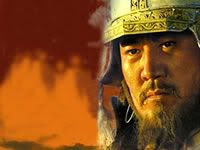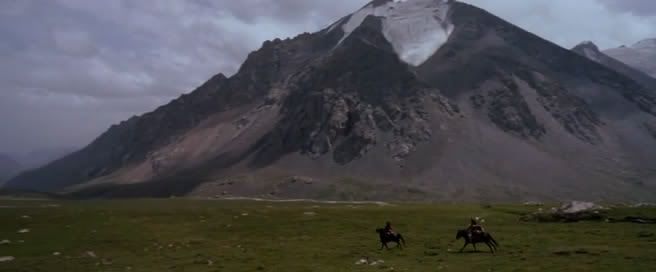Post by Subu'atai on Jul 5, 2008 19:11:30 GMT 3
The reason I made this individual thread, is because the other thread is totally stuffed, and the only Dzungar got himself banned by acting like an idiot.
Ne ways, Bor Chono - I ask that you put aside your negative posture against Oirats in regards to this topic. We are both Mongols, and no I'm not one of those idiots Kalmyk nationalists nor am I nemesis incarnated. I stand for Pan-Mongolism and everything that stands for. History is history.
I have no ill will towards you and in fact I find your humor and posts rather entertaining and fun to read. Now since we got this out of the way, let me see. Ok the original posts by Qaghan is this:
 Let us talk about the Oirat Khanate.
Let us talk about the Oirat Khanate.
When was it founded? When did it cease to exist? Does anyone have a list of their rulers? Which territories did they control?
Thank you
ORIGINS
The ancestry of the Oirats is from Naiman, Kerait and Merkit stock. However the first Oirats were a group that emerged after the fall of the Yuan Dynasty in China and began the long feud against Halh Mongolia for the next 400 years.
TERM
Oirat comes from the term Dörben Oirat also known as the "Alliance of Four". It started with four western Mongolian tribes Khoshut, Choros, Dörbet and Torghut, then incorporated other tribes such as the Zachachin, Bayids and Uriankhai.
EARLY HISTORY
Oirats were never fully united into a single power for the longest time. Toghon Tayisi in the 15th century expanded Oirat rule greatly but after his son Esen Tayisi (Who managed to capture a Ming emperor) was slain in civil war - over his diplomatic screwup with the Ming. The Oirats fell into disunity and fought amongst themselves.
RISE OF THE DZUNGARS
In 1606 however, Khara Khula emerged to unite the Oirats against the Halhas who was attempting to annex Oirat territory. He himself was descendant of Esen, and formed the Dzungar nation. He didn't call himself a Khan however, and was strictly a military ruler. In 1609 he won a decisive victory against the Halhs and established sovereignity over Dzungaria, but it wasn't until 1623 that Ubashi Khong Tayiji - Khan of the Altan Mongols was killed and thus established Dzungar independence from the Mongols.
Dzungars did not have a Khaan until 1671 by Galdan Khaan. It was during this period that the Dzungar Khanate came to be as it is famously known - territories owned were Dzungaria, East Kazakhstan, and Kyrgyzstan by 1679.
PAN-MONGOL CONQUESTS
As Manchuria grew in power to the East however, Galdan Khaan wanted to re-unite the Mongols by invading Mongolia in 1688. He was backstabbed by his nephew Tsewang Rabtan who usurped his throne in 1689 however.
Dzungar armies advanced all the way to Eastern Mongolia, then proceeded south as the Halh royalty fled to inner-Mongolia - who then surrendered themselves to the Manchus for their support against Dzungar armies. The Qing Emperor agreed, and sent a letter to Galdan asking for peace - however, it was not peace he had intended.
The battle of Ulaan Budan was no battle. It was an ambush, crushing Galdan's unprepared forces and forced him back to Halh Mongolia. Galdan was isolated from Dzungaria (which his nephew usurped) and could not recover from this defeat. By 1696 a combined force of Halh Mongols and Manchus invaded Mongolia and encircled Galdan's remaining forces at the battle of Zuunmod. Queen Anu sacrificed her life to save Galdan from encirclement in which he survived - but killed himself in 1697 to avoid capture.
AFTERMATH
The Dzungars were completely in disarray at this time fighting amongst themselves over succession. It was completely lawless, and its people were also inflicted with the smallpox epidemic which spread across the region at that time. It was during this time when Prince Amursana also betrayed the Dzungars by joining with the Manchus on the condition that he would be called Khan. He had his own plans however but was found out somehow and fled to the Russians for refuge.
GENOCIDE
In 1755, Cebdenjab, son of a Halh Mongol prince, led the expedition for the Qing Emperor and exterminated the remainder of the Dzungar people who did not migrate westwards towards the Caucasus. It was genocide, numbers are unknown - it is unknown also whether the majority of the population were killed due to small-pox or by the expedition. All were massacred, including men, women, and children in Dzungaria. After the final Khan Dawa Achi was slain in 1759 that the massacre ended. The Qing Emperor repopulated the territory then called it Xinyiang - or "New territory".
This is the end of the Dzungar Khanate, and the beginning of the Kalmyk Khanate in the Caucasus - which I'll do later.
Ne ways, Bor Chono - I ask that you put aside your negative posture against Oirats in regards to this topic. We are both Mongols, and no I'm not one of those idiots Kalmyk nationalists nor am I nemesis incarnated. I stand for Pan-Mongolism and everything that stands for. History is history.
I have no ill will towards you and in fact I find your humor and posts rather entertaining and fun to read. Now since we got this out of the way, let me see. Ok the original posts by Qaghan is this:
When was it founded? When did it cease to exist? Does anyone have a list of their rulers? Which territories did they control?
Thank you

ORIGINS
The ancestry of the Oirats is from Naiman, Kerait and Merkit stock. However the first Oirats were a group that emerged after the fall of the Yuan Dynasty in China and began the long feud against Halh Mongolia for the next 400 years.
TERM
Oirat comes from the term Dörben Oirat also known as the "Alliance of Four". It started with four western Mongolian tribes Khoshut, Choros, Dörbet and Torghut, then incorporated other tribes such as the Zachachin, Bayids and Uriankhai.
EARLY HISTORY
Oirats were never fully united into a single power for the longest time. Toghon Tayisi in the 15th century expanded Oirat rule greatly but after his son Esen Tayisi (Who managed to capture a Ming emperor) was slain in civil war - over his diplomatic screwup with the Ming. The Oirats fell into disunity and fought amongst themselves.
RISE OF THE DZUNGARS
In 1606 however, Khara Khula emerged to unite the Oirats against the Halhas who was attempting to annex Oirat territory. He himself was descendant of Esen, and formed the Dzungar nation. He didn't call himself a Khan however, and was strictly a military ruler. In 1609 he won a decisive victory against the Halhs and established sovereignity over Dzungaria, but it wasn't until 1623 that Ubashi Khong Tayiji - Khan of the Altan Mongols was killed and thus established Dzungar independence from the Mongols.
Dzungars did not have a Khaan until 1671 by Galdan Khaan. It was during this period that the Dzungar Khanate came to be as it is famously known - territories owned were Dzungaria, East Kazakhstan, and Kyrgyzstan by 1679.
PAN-MONGOL CONQUESTS
As Manchuria grew in power to the East however, Galdan Khaan wanted to re-unite the Mongols by invading Mongolia in 1688. He was backstabbed by his nephew Tsewang Rabtan who usurped his throne in 1689 however.
Dzungar armies advanced all the way to Eastern Mongolia, then proceeded south as the Halh royalty fled to inner-Mongolia - who then surrendered themselves to the Manchus for their support against Dzungar armies. The Qing Emperor agreed, and sent a letter to Galdan asking for peace - however, it was not peace he had intended.
The battle of Ulaan Budan was no battle. It was an ambush, crushing Galdan's unprepared forces and forced him back to Halh Mongolia. Galdan was isolated from Dzungaria (which his nephew usurped) and could not recover from this defeat. By 1696 a combined force of Halh Mongols and Manchus invaded Mongolia and encircled Galdan's remaining forces at the battle of Zuunmod. Queen Anu sacrificed her life to save Galdan from encirclement in which he survived - but killed himself in 1697 to avoid capture.
AFTERMATH
The Dzungars were completely in disarray at this time fighting amongst themselves over succession. It was completely lawless, and its people were also inflicted with the smallpox epidemic which spread across the region at that time. It was during this time when Prince Amursana also betrayed the Dzungars by joining with the Manchus on the condition that he would be called Khan. He had his own plans however but was found out somehow and fled to the Russians for refuge.
GENOCIDE
In 1755, Cebdenjab, son of a Halh Mongol prince, led the expedition for the Qing Emperor and exterminated the remainder of the Dzungar people who did not migrate westwards towards the Caucasus. It was genocide, numbers are unknown - it is unknown also whether the majority of the population were killed due to small-pox or by the expedition. All were massacred, including men, women, and children in Dzungaria. After the final Khan Dawa Achi was slain in 1759 that the massacre ended. The Qing Emperor repopulated the territory then called it Xinyiang - or "New territory".
This is the end of the Dzungar Khanate, and the beginning of the Kalmyk Khanate in the Caucasus - which I'll do later.











